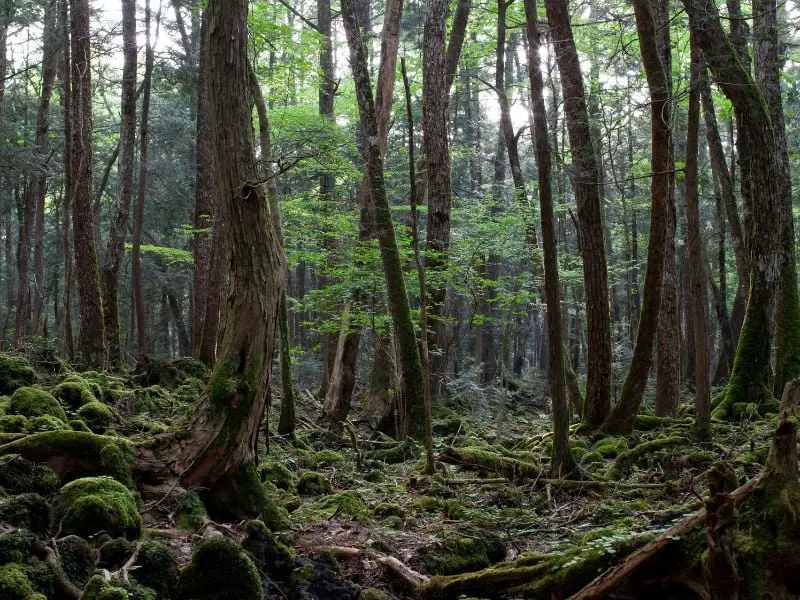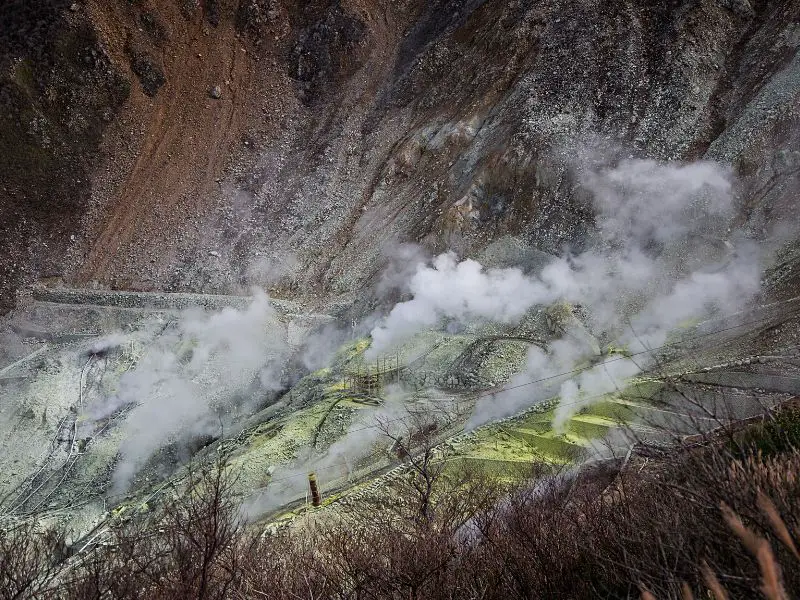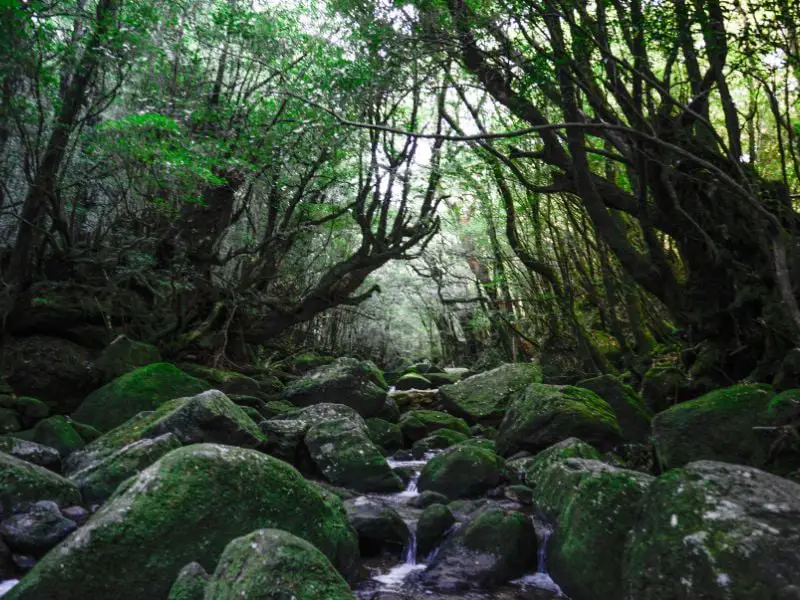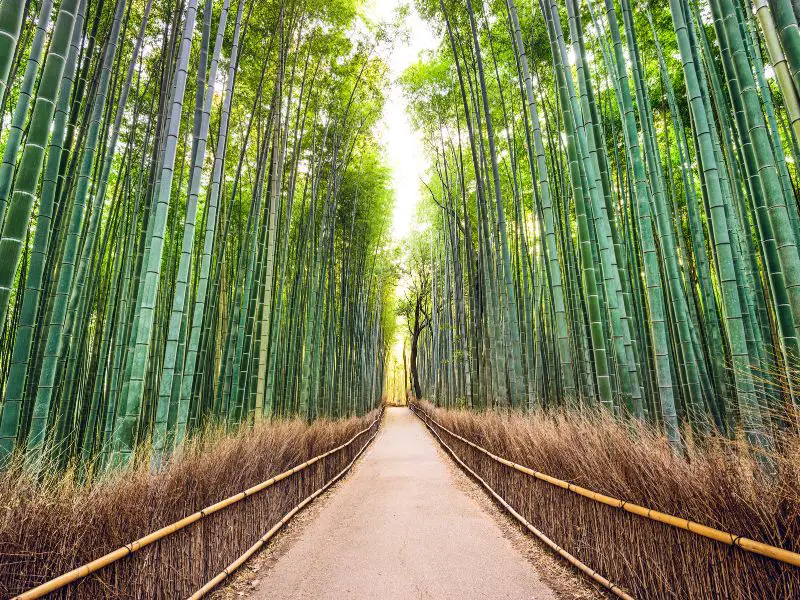When you fly over Japan, you can’t help but notice how many forests in Japan there are. Even though Japan has a lot of factories and is one of the most crowded places on Earth, forests cover around 67% of its land. Finland and Sweden are the only highly industrialized countries with about the same forest cover as Japan. However, their populations are only about 4.5% and 6.0% of Japan’s. No other industrialized country has more than half of its land covered by forests. In this article, we’ll dive into the forests in Japan.

“The forest is a peculiar organism of unlimited kindness and benevolence that makes no demands for its sustenance and extends generously the products of its life and activity.”
– Buddhist philosopher, D.T. Suzuki
Forests of Japan
Range
The Japanese archipelago is about 3,000 km long and a few hundred km wide from north to south. This makes it possible for many kinds of trees to grow, including conifers in the north, deciduous broadleaves, evergreen broadleaves further south, and mangrove swamps in the subtropical south.
Deforestation
The downfall of the forests in Japan began some 3,000 years ago when the Korean Peninsula introduced irrigation techniques for intensively farming rice in Japan. This new, highly productive rice farming method expanded across the warm temperate regions and fueled population growth, resulting in ever-increasing quantities of trees being cut down for fuel, and timber and clearing more land for farming. This loss intensified when the Japanese started smelting iron, which needed vast amounts of wood to keep the kilns (Tatara) burning.
Modern Forestry
Japan has developed a complex and sophisticated form of forest management that other countries are adopting ever since. In 1992 Japan developed a national forest standard. This set of criteria is used throughout the country for forest management.
Some of these standards include reforestation in the areas previously used for logging, regeneration of natural forest lands, and protection or improvement of natural forest ecosystems. Other countries are also developing similar standards, like the UK’s efforts to introduce a forest code and the European Commission’s intention to create a European Forest Code.
Japan’s forestry industry has around 5 million forest workers supporting it, and the industry is significant to Japan’s GDP. All this will continue to be supported according to government policies.
Sacred Forests in Japan
Sacred forests in Japan often feature tall, ancient trees, especially cedars. They are likely holy sites with groves of tall trees. You can find this often in crossroads or village entrances, and they symbolize the local guardian spirit. Some believe they are gateways to Yomi, the country of the dead, which links to the story of the creator god Izanagi seeking his wife Izanami in Yomi after she died after creating the fire kami. To celebrate the union of guardian spirits and fertility gods, the Japanese put phallic emblems made of stone or wood in specific holy groves.
Consequences of Global Warming on Flora in Japan
- Plants and animals that dwell in fragile alpine and northern areas may face extinction due to global warming.
- There will be more allergy-inducing Japanese cedars corrupting Northern Japan’s beech woods.
- Beeches grow best in areas that get plenty of snow in the winter and have mild summers. As the planet warms, it is threatening and already pushing them northward.

Trees and Religion in Japan
In Japan, more than fifteen species (Tujii, 1995) are traditionally associated with Shinto or Buddhism. Most are found in southwest Japan. Here are some trees that have deep meaning in Japan.
- Pinetrees known as Mastu, means “waiting for a god’s soul to descend from heaven.” It is a tradition to plant pine trees around shrines and temples and put pine twigs at the entrances of homes every new year to ask the gods for blessing.
“A pine tree stands alone in the cold autumn rain. It sheds tears that glisten like jewels.”
– Izumi Shikibu
- Sakaki tree or the origin name Sakai means boundary. Twigs and leaves are offered to the Shinto gods in holy places as a means of cleansing.
- Bamboo, often grown in holy places, is called the holy tree on fields, where farmers ask for a bountiful harvest.
- The peach tree is often believed to repel devils or thunder.
Most Popular Forests in Japan
1. The Aokigahara Forest
In Japanese mythology, this forest has a long history of being a haven for yrei, or spirits of the dead. Since the 1960s, Aokigahara has been connected with suicide, earning the label “Suicide Forest” in English and sadly being renowned as one of the world’s most popular suicide locations in the world.
“The clearest way into the Universe is through a forest wilderness.”
– John Muir
2. Owakudani
Owakudani, also known as the big boiling valley, is a volcanic valley in Hakone, Kanagawa Prefecture, Japan, with active sulfur vents and hot springs. It was formed around 3,000 years ago by the eruption of the Hakone volcano.
It is a renowned tourist destination because of its picturesque vistas, volcanic activity, and kuro-tamago, a local specialty of eggs hard-boiled in hot springs. According to locals, consuming one of these black eggs adds seven years to your life.
3. Yakushima Kagoshima Forest
The subtropical island of Yakushima, a part of Kagoshima Forest, is located off the southern coast of Kyushu. A sizable cedar forest that includes some of Japan’s oldest surviving trees covers the area. Yakusugi, a combination of Yakushima and sugi, the Japanese word for cedar, is a term used to refer to trees that are more than 1000 years old. The oldest of these trees might be over 7000 years old.

“Forests are the lungs of our land, purifying the air and giving fresh strength to our people.”
– Franklin D. Roosevelt
4. The Arashiyama Sagano Bamboo Forest
Arashiyama Bamboo Grove, also known as Sagano Bamboo Forest, is the most well-known bamboo forest in Japan and is located on the outskirts of Kyoto. It’s widely considered one of Kyoto’s most photographed locations and one of the city’s most photo-shopped. The Iwatayama Monkey Park, located on Mount Arashiyama, is home to around 100 Japanese macaques.

“In every walk with nature, one receives far more than he seeks.”
– John Muir
5. Suzume-no Oyado Ryokuchi Park
Suzume-no Oyado Ryokuchi Park in Meguro has a 200-year-old bamboo grove and a rebuilt historic Japanese home. Both are available to visitors, and this is generally regarded as one of Tokyo’s most magnificent bamboo woods. The park is modest and peaceful, so it’s perfect for visitors who want to escape the rush and bustle of Tokyo.
Related: Most Endangered Plants in the World, Best Hanging Plants, Fast-Growing Trees
Bottomline
Trees form an essential part of Japanese culture. These trees were used as spiritual worship sites and are critical to the Japanese way of life. All of the trees in Japan are protected by strict law, as no tree can be cut down without the permission of the Rakki Forest Office and approval from the Ministry of Agriculture, Forestry, and Fisheries.
They also encouraged local communities to plant trees to support a healthy ecosystem. Forests in Japan are some of the finest in the world because of their unique geographical features, which make them distinctive to the planet.



;?>/smartquizbuilder/includes/images/sqb-registration-img.jpg)




1 thought on “Mystical Forests in Japan: A Journey Through the Land of the Rising Sun”